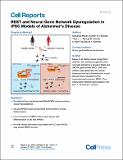REST and Neural Gene Network Dysregulation in iPSC Models of Alzheimer’s Disease
Author(s)
Meyer, Katharina; Feldman, Heather M.; Lu, Tao; Drake, Derek; Lim, Elaine T.; Ling, King-Hwa; Bishop, Nicholas A.; Pan, Ying; Seo, Jinsoo; Lin, Yuan-Ta; Su, Susan C. (Susan Chih-Chieh); Church, George M.; Tsai, Li-Huei; Yankner, Bruce A.; ... Show more Show less
DownloadPublished version (6.224Mb)
Terms of use
Metadata
Show full item recordAbstract
The molecular basis of the earliest neuronal changes that lead to Alzheimer’s disease (AD) is unclear. Here, we analyze neural cells derived from sporadic AD (SAD), APOE4 gene-edited and control induced pluripotent stem cells (iPSCs). We observe major differences in iPSC-derived neural progenitor (NP) cells and neurons in gene networks related to neuronal differentiation, neurogenesis, and synaptic transmission. The iPSC-derived neural cells from SAD patients exhibit accelerated neural differentiation and reduced progenitor cell renewal. Moreover, a similar phenotype appears in NP cells and cerebral organoids derived from APOE4 iPSCs. Impaired function of the transcriptional repressor REST is strongly implicated in the altered transcriptome and differentiation state. SAD and APOE4 expression result in reduced REST nuclear translocation and chromatin binding, and disruption of the nuclear lamina. Thus, dysregulation of neural gene networks may set in motion the pathologic cascade that leads to AD.
Date issued
2019-01Department
Massachusetts Institute of Technology. Department of Brain and Cognitive Sciences; Picower Institute for Learning and MemoryJournal
Cell Reports
Publisher
Elsevier BV
Citation
Meyer, Katharina et al. "REST and Neural Gene Network Dysregulation in iPSC Models of Alzheimer’s Disease." Cell Reports 26, 5 (January 2019): P1112-1127.e9 © 2019 The Author(s)
Version: Final published version
ISSN
2211-1247